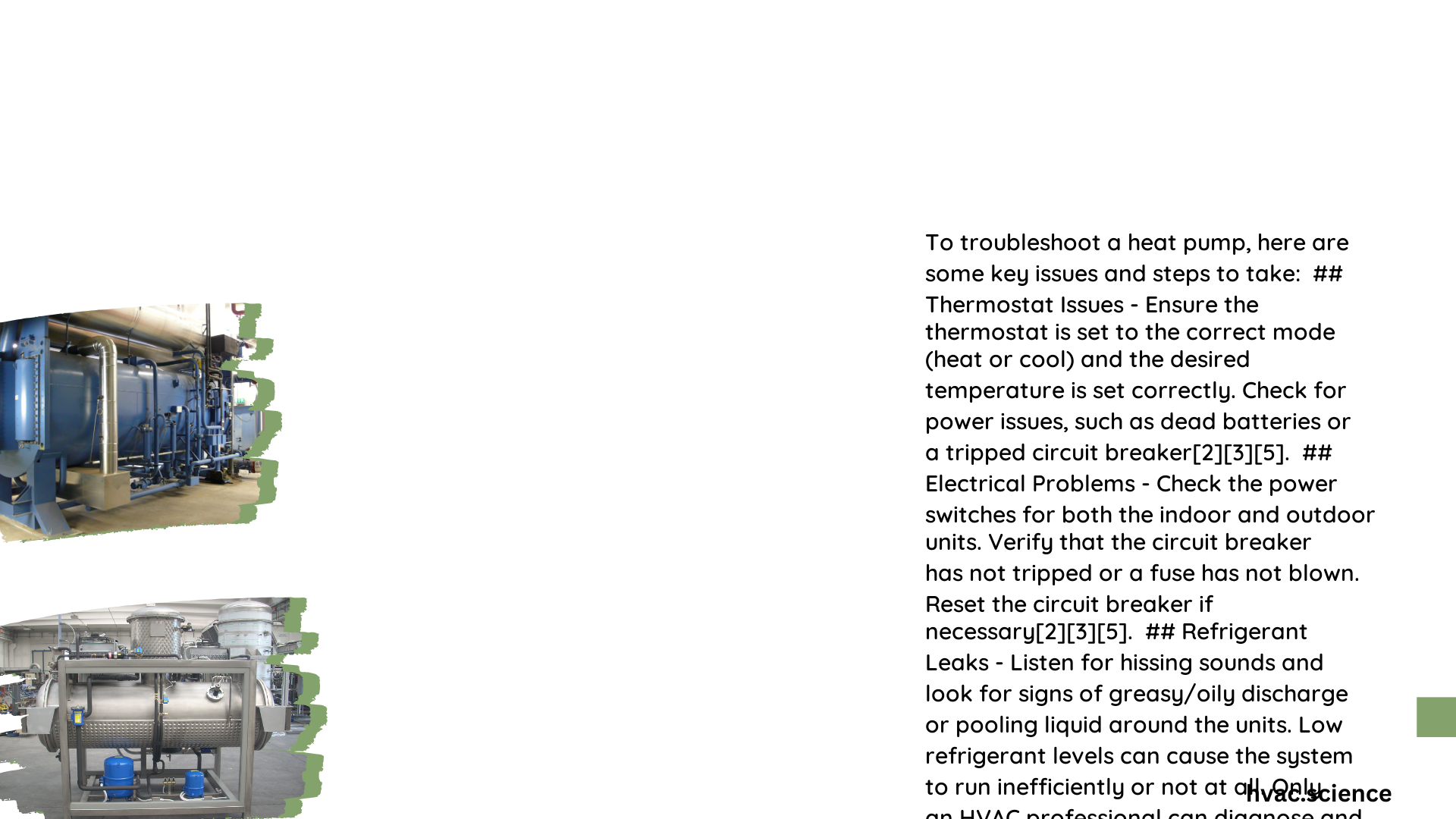HEC heat pump troubleshooting involves identifying and resolving common issues such as the unit not turning on, insufficient heating or cooling, strange noises, and leaks. This guide provides step-by-step solutions for diagnosing and fixing problems with HEC heat pumps, covering electrical issues, refrigerant leaks, thermostat malfunctions, and maintenance tips to ensure optimal performance and efficiency.
What Are the Most Common HEC Heat Pump Issues?
HEC heat pumps, like other brands, can experience various problems that affect their performance. Here are some of the most frequent issues:
- Unit fails to turn on
- Insufficient heating or cooling
- Unusual noises during operation
- Leaking water or refrigerant
- Short cycling
- Frozen evaporator coil
- High energy bills
How to Troubleshoot a HEC Heat Pump That Won’t Turn On?

If your HEC heat pump refuses to start, follow these steps:
- Check the thermostat:
- Ensure it’s set to the correct mode (heat or cool)
-
Verify the desired temperature is different from the current room temperature
-
Inspect the electrical supply:
- Check if the circuit breaker is tripped
- Verify that power switches for both indoor and outdoor units are on
-
Reset the breaker if necessary
-
Examine the wiring:
- Look for frayed or damaged wires
-
Replace any compromised wiring
-
Test the start capacitor:
- Listen for a faint clicking noise, which may indicate a faulty capacitor
- Contact an HVAC technician for replacement if needed
What Steps Should I Take When My HEC Heat Pump Isn’t Heating Properly?
When your HEC heat pump is running but not providing adequate heat, try these troubleshooting steps:
- Clean or replace the air filter:
- Check the filter every 30 days
- Clean reusable filters with soapy water and air dry
-
Replace disposable filters as needed
-
Inspect and clean the coils:
- Use an HVAC fin comb to straighten bent fins
- Remove debris with a soft brush and garden hose
-
Ensure proper airflow around the coils
-
Check the blower drive belt:
- Look for signs of wear, looseness, or slipping
-
Tighten or replace the belt if necessary
-
Investigate potential refrigerant issues:
- Listen for hissing sounds indicating a leak
- Look for greasy/oily discharge or icing on the evaporator coils
- Contact a professional to repair leaks and recharge refrigerant
How Can I Prevent Frost Buildup on My HEC Heat Pump’s Evaporator Coil?
Frost on the evaporator coil can significantly reduce your HEC heat pump’s efficiency. Here’s how to prevent it:
- Maintain clean air filters:
-
Regularly clean or replace filters to ensure proper airflow
-
Check the blower drive belt:
-
Ensure the belt is not loose or slipping
-
Verify thermostat functionality:
- Consult the thermostat manual for proper settings
-
Test the thermostat and replace if necessary
-
Ensure proper defrost cycle operation:
- Contact a professional to check the defrost control board and sensors
What Should I Do If My HEC Heat Pump Is Leaking Liquid?
If you notice liquid leaking from your HEC heat pump, take these steps:
- Inspect the drain pan:
- Clean out any debris or blockages
-
Check for damage and contact a professional for replacement if needed
-
Identify the type of liquid:
- Clear water is likely condensation
-
Oily or colorful liquid may indicate a refrigerant leak
-
Check for refrigerant leaks:
- Look for signs of oil around fittings or connections
- Listen for hissing sounds
- Contact a certified technician to locate and repair any leaks
How Often Should I Perform Maintenance on My HEC Heat Pump?
Regular maintenance is crucial for optimal performance and longevity of your HEC heat pump. Follow this schedule:
| Maintenance Task | Frequency |
|---|---|
| Check/clean air filter | Every 30 days |
| Clean outdoor unit | Every 3-6 months |
| Inspect and clean coils | Annually |
| Check refrigerant levels | Annually |
| Professional tune-up | Annually |
What Are Some DIY Maintenance Tips for HEC Heat Pumps?
Here are some maintenance tasks you can perform yourself:
- Clean or replace air filters regularly
- Remove debris from around the outdoor unit
- Clean the evaporator and condenser coils (if accessible)
- Check and clean the condensate drain line
- Inspect and tighten electrical connections
- Lubricate moving parts (if applicable)
- Test thermostat functionality
When Should I Call a Professional for HEC Heat Pump Repairs?
While some troubleshooting can be done DIY, certain situations require professional attention:
- Refrigerant leaks or recharging
- Electrical issues beyond simple breaker resets
- Compressor or motor failures
- Persistent heating or cooling problems
- Strange noises or vibrations
- Any issue you’re not comfortable addressing yourself
Remember, working with refrigerants requires EPA certification, and improper handling can be dangerous and illegal.
How Can I Improve the Efficiency of My HEC Heat Pump?
To maximize your HEC heat pump’s efficiency:
- Maintain proper insulation in your home
- Use programmable or smart thermostats
- Keep air vents unobstructed
- Schedule regular professional maintenance
- Upgrade to a more efficient model if your current unit is old
By following these troubleshooting and maintenance tips, you can ensure your HEC heat pump operates efficiently and effectively for years to come.
References:
1. Heat Pump Troubleshooting and Repair Chart
2. Heat Pump Not Turning On? Here’s What To Check
3. Heat Pump Troubleshooting: 12 Common Issues & Steps to Take
